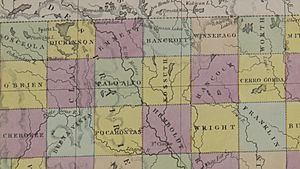Bancroft County, Iowa facts for kids
Quick facts for kids Bancroft County |
|||||||||
|---|---|---|---|---|---|---|---|---|---|
| County of Iowa | |||||||||
| 1851–1857 | |||||||||
 Location within the U.S. state of Iowa |
|||||||||
| History | |||||||||
|
• Established
|
1851 | ||||||||
|
• Disestablished
|
1857 | ||||||||
| Contained within | |||||||||
| • Country | |||||||||
| • State | |||||||||
|
|||||||||
| Today part of | |||||||||
Bancroft County, Iowa, was a county located in what today is the northern portion of Kossuth County. The county was established in 1851 by the Iowa General Assembly, but then abolished six years later. The area was joined to Kossuth County, leading to it being roughly twice the size of adjacent counties. The reason that it became a part of Kossuth County was because the area was wetland, consequently making it unsuitable for farming. Now, only a small amount of the wetlands remain, mostly at the Union Slough National Wildlife Refuge. The remainder of the land is arable by modern farming standards.
The county was named for historian and statesman George Bancroft (1800–1891).
There never was a county seat established or the organization of a county government.
Background
On May 13, 1870, Crocker County was formed out of the same area as Bancroft County, the 12 northern townships of Kossuth. The county seat of Crocker was Greenwood Center.
Many southern Kossuth settlers were unhappy because they did not want the county to be divided, hoping to have the honor of being the largest county.
However, it later merged back into Kossuth County when it was discovered that Crocker was unconstitutional as it was under 432 square miles of territory, the minimum according to the Iowa Constitution.
Attempts of re-establishment
On February 22nd, 1913, legislation was introduced again to create a new county in the northern area of Kossuth. The proposed region would be called Larrabee County named after governor William Larrabee.


